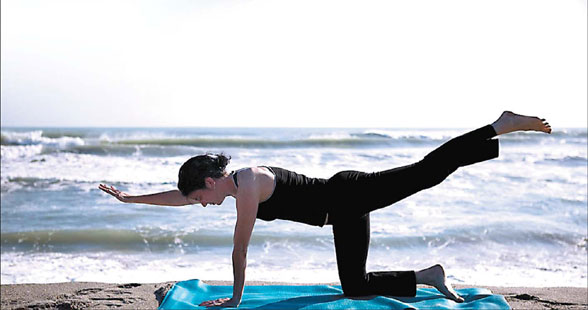For some time now, core stability training has been a fitness-industry panacea. Without it, we are told, you risk poor posture, lower back pain, mediocre sports performance and a less than flat stomach.
But, says Spencer McGawley, a functional fitness and therapy specialist, "Many experts are adopting the view that core stability training is limited in its functionality. That's not to say it has no value at all, but it has been taken out of context, and its benefits wildly overplayed by the fitness industry."
The premise of core stability training is that certain muscles in the trunk and pelvic area have a role in protecting the spine and keeping the core of the body stable, thereby giving a solid foundation from which the limbs can work.
Core stability workouts target muscles that, so the theory goes, are lazy and do not "switch on" when needed. The main player is the transversus abdominis (TA), a muscle that wraps round the lower trunk, which is engaged by pulling the navel towards the spine in a move called "abdominal hollowing".
"Much of the focus on the TA came from Australian research which found that lower back pain sufferers had TA dysfunction," McGawley explains. This led to a belief that back pain was caused by the TA not "being recruited" in time to protect the spine during movement, and that isolating the core muscles would "retrain" them. The evidence to support this is equivocal.
A recent study from the University of Queensland found that isolation of the deep abdominal muscles could successfully improve recruitment patterns in lower back pain sufferers, while training the trunk muscles in a non-isolated manner (performing general abdominal exercises) could not.
But Stuart McGill, a professor of spine biomechanics at the University of Waterloo in Ontario - and a pioneering researcher in the area - now believes that strengthening the TA can worsen back pain and reduce back stability.
In a recent study, he and his team found that abdominal hollowing worked less effectively in stabilizing the lumbar spine than a full abdominal muscle co-contraction (basically, contracting or "bracing" the whole area).
Therefore, says McGill, "There seems to be no mechanical rationale for using an abdominal hollowing action, or the TA, to enhance stability."
Other experts are dubious about our ability to "override" the neuromuscular system and teach muscles when to switch on and off.
"I've seen many lower back pain cases who are failing to get better because of core work," says Roy Palmer, an Alexander technique teacher and sports coach. "Trying to control the actions of specific muscles is in opposition to the nervous system's role in ensuring that movement is executed with minimal stress to the body. We should not attempt to directly control muscle recruitment for movement or exercise. It should be the thought of an act that initiates our total muscle response."
For healthy people in search of a flatter tummy or a more powerful running stride, here, too, a growing number of experts believe that core stability training falls short.
"Core stability was born out of a specific problem: lower back pain," says Diane Kheir, an osteopath who lectures on core stability. "It was never meant to apply to the general population, and for most people, there are better ways of working these muscles. Rather than have everyone lie on the floor with their legs in the air, exercise classes would be better teaching correct standing, sitting and transferring of weight from one leg to another. Teachers could ensure that participants learn moves that relate either to their normal daily tasks - there hasn't been enough attention to the connection between an exercise and its relevance to daily living."
"Core stability training isn't tailored to most sports," says Professor Eyal Lederman, an osteopath whose research centers on the development of neuromuscular and movement rehabilitation. In other words, it doesn't replicate the activities involved in those sports.
While some question the very validity of stability exercise, others are more concerned that it is being taught wrongly. Pilates, practically royalty as far as core stability workouts are concerned, has recently come under fire from many quarters.
But according to Suzanne Scott, founder member of the Pilates Foundation, it's not Pilates that is at fault, but its misapplication and unrealistic client expectations.
"In the public perception, Pilates has come to equal core stability," says Scott, who works with elite athletes in functional retraining. "It is presented as being about lying on the floor doing isolated muscle exercises, which isn't what it is about at all. Pilates' original approach was far more holistic."
Scott believes Pilates has been a victim of its own success; demand from the general public has resulted in large classes and insufficient experienced teachers. "We discourage our students from teaching large groups of varied ability and experience. The ideal is small, pre-assessed groups, combined with some one-on-one time," she says.
Core stability training does have its uses, though. "The core should work naturally," says Kheir. "It's what's known as a 'pre-anticipatory' muscle group - it fires before other muscles fire. The only time it won't kick in is if someone has lower back pain, or has had some kind of abdominal surgery or injury, in which case the person may need help in trying to locate and recruit it again."
Experts warn core stability training is not tailored for everybody. Photos courtesy of Quanjing
(The Guardian via China Daily February 20, 2008)



